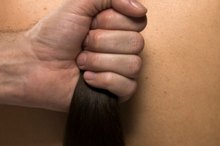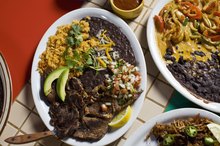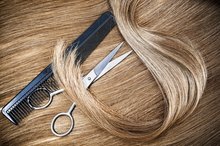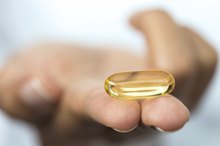How to Increase Keratin
Living cells in your skin, called keratinocytes, produce a protective layer that provides flexible strength and keeps water and other external material out of your body. Keratinocytes provide this strength by producing a tough, triple-helix-shaped protein strand called keratin. Keratin is the primary constituent of skin, hair, nails and tooth enamel. The number of disulfide bonds that form between the three strands of the amino acid allow it to be flexible, as it is in skin and hair, or make it strong and hard, as it is in nails, animal hooves and tooth enamel. You can increase your keratin by consuming foods that are used to produce the keratin or by applying keratin-enhancing products topically.
Maintain a diet rich in protein. Protein provides amino acids needed by the keratinocytes to produce keratin. For the sake of your cardiovascular health, avoid or minimize fatty red meats. Eat lean meats, fish, yogurt and low-fat dairy to infuse your body with the essential amino acids that boost keratin production and enhance your skin, hair and nails.
Dry and Brittle Hair & Diet
Learn More
Consume iron-rich food. Iron helps red blood cells transport oxygen to your hair follicles, as well as to the other tissues that benefit from iron. Animal protein provides iron that is easily absorbed by the body. Iron-rich animal protein includes turkey, duck, chicken, pork, shrimp, eggs, lean beef and lamb. Plant foods that contain iron-rich protein include beans, black-eyed peas, soybeans, tofu and lentils.
Eat foods with plenty of vitamin C. Vitamin C enhances the absorption of vegetarian-based iron, so consume vitamin C foods at the same time that you eat vegetable-based protein. Foods rich in vitamin C include broccoli, Brussels sprouts, kale, peppers, guava, papaya, grapefruit, oranges, pineapple, strawberries and lemons.
How to Strengthen Hair Follicles
Learn More
Boost your intake of B vitamins. The B vitamins enhance creation of red blood cells, which in turn carry nutrients and oxygen to your scalp, follicles and growing hair. Foods with vitamin B-6 or B-12 include wild salmon, trout, shellfish, white potatoes with the skin, bananas, lentils, garbanzo beans, fortified whole-grain cereals, lean beef, chicken breasts and pork tenderloin. Foods with folate include oatmeal, fortified whole-grain cereal, spinach, beets, parsnips, broccoli, okra, black-eye peas and soybeans.
Consume foods with zinc, such as oysters, crab, pork tenderloin, turkey, veal, chicken, peanut butter, wheat germ and chickpeas. Zinc facilitates hair and tissue growth and repair and helps maintain the oil glands that surround hair follicles.
Use keratin formulated shampoos to nourish and supplement the keratin in your hair. Keratin shampoos help repair damaged hair, protect against further breakage and add elasticity and shine. Keratin treatments, available at salons and also for home treatment, use high temperature flat irons to make the keratin bond more effectively with your hair.
Tips
Don’t expect immediate results. The food you eat now affects the growth of new keratin. It will take 6 to 12 months for your hair to show the results.
Increased keratin will help strengthen hair, but it won’t affect thinning hair due to male pattern baldness.
Avoid keratin hair treatments that contain more than 2 percent formaldehyde.
Related Articles
References
- Beauty Tip Today: Help Me!! My Hair is Fried!!
- KeratinTreatmenForHair.com: FAQs
- MSNBC: Losing Your Locks? These Foods Can Help
- “Pathophysiology: The Biologic Basis for Disease in Adults and Children,” Sixth Edition; Kathryn L McCance, et al.; 2010
Writer Bio
Jon Williams is a clinical psychologist and freelance writer. He has performed, presented and published research on a variety of psychological and physical health issues.









